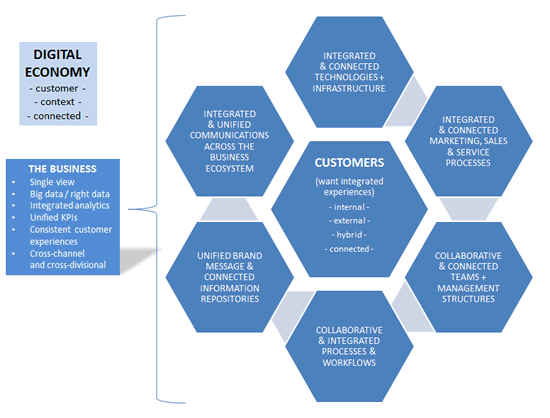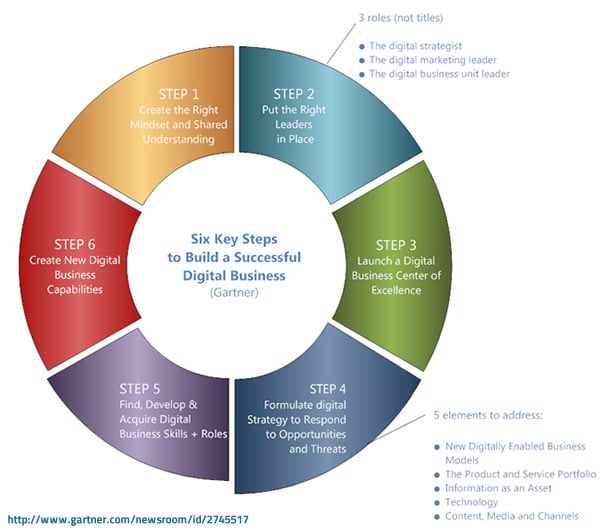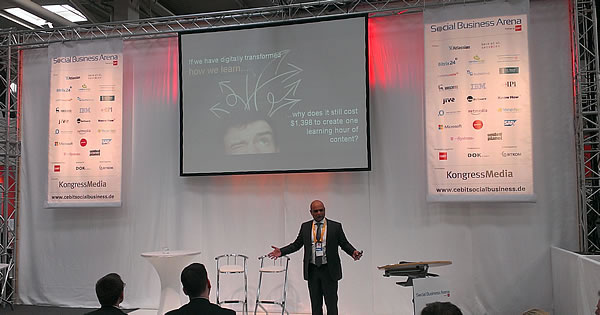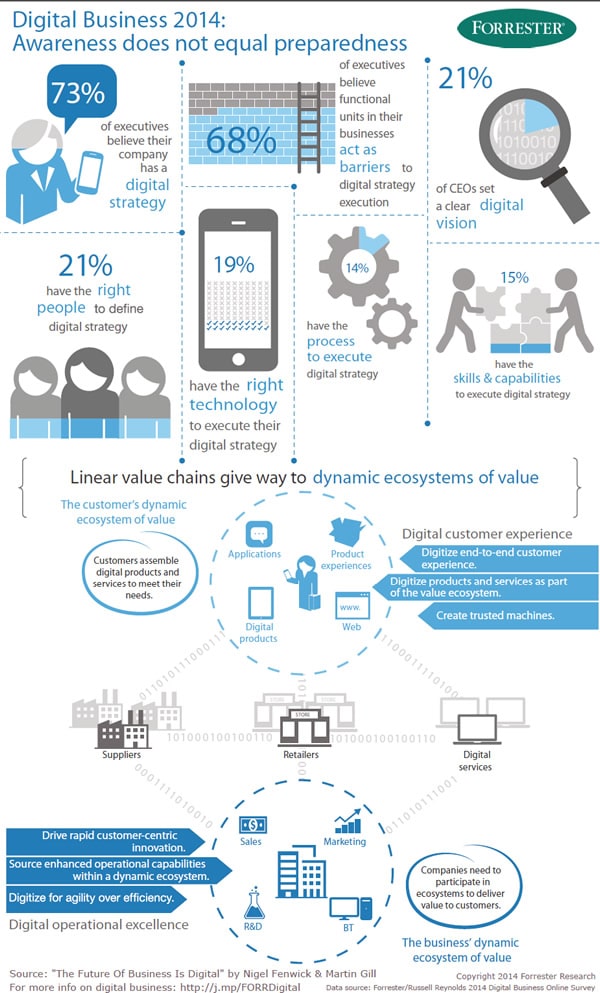Digital technologies have profoundly changed the ways we do business, buy, work and live. They have even altered society and continue impacting virtually all business functions and industries. It’s partially what digital business is about.
Digital business is the creation of new business designs by blurring the digital and physical worlds
Digital business mainly is used in a context of digital transformation, holistic business optimization, disruption and integration/convergence. However, it’s much more than that. It’s also about digital marketing transformation, social business and – as we can never forget the human element that risks being ignored amidst the avalanche of new technologies and the digital fascination – human augmentation and simply business between people with technology as an interface/enabler.
A key part of it all is information – put at work, which requires a holistic information management and data management approach – and connecting value to create more value, throughout the entire ecosystem.
Digital business and beyond: definitions and context
As digital technologies offer new ways to connect, collaborate, conduct business and build bridges between people, it touches the core of all business functions and even the ways organizations are managed.
Digital technologies have also challenged existing business models and continue to do so. One of the key driving forces of it is the capacity of innovation and the consumerization of IT certainly also plays a role.
Digital business is about that stage you see in many maturity models (in marketing, ICT, social, business, you name it): the converged – or fully connected/integrated stage. From a sheer technology perspective it goes beyond the famous third platform and beyond technologies such as cloud computing, the Internet of Things, mobile, Big Data, etc. Tech is but an enabler, while each vertical/organization could leverage them differently and with cybersecurity and cyber resilience as horizontal pillars, regardless of vertical.
The need to integrate
As a term, ‘digital business’ got more attention when Forrester’s Nigel Fenwick wrote a blog post “2013: The Year Of Digital Business“. He looked at the social business evolutions – stating they would certainly continue to evolve – but rightfully said that social tools “have not removed the complexity or decreased the volume of information we must process”.
“Social tools”, Nigel continued, “are not the silver bullet”. While Nigel wanted to emphasize “the need to rethink business processes, taking this new communications paradigm into account”, others, such as Gartner (see below) are more looking at the disruptive element when defining digital business.
Nigel also mentioned what, according to us matters most: the customer experience (in the broadest possible sense) and also the convergence dimension.
An organization’s reason for being, like that of any organism, is to help the parts that are in relationship to each other, to be able to deal with change in the environment. That means that they are trying to anticipate the future in some way or another. This is true of the separate pieces of a cell, of the cells in a body, of the bodies in a society, of the societies in an economy. Each system is trying to anticipate change in the environment. Kevin Kelly in The Structure Of Organized Change, A conversation with Kevin Kelly by Joe Flower (1995).
Simply said: all stuff comes together and gets closely connected and integrated for a reason (from objectives to consumer demand and sheer necessity to survive and “pro-dapt”). In that regard, read “Can you survive the age of integration and collaboration?” (it’s where we first put the little graphic you find below and mentions the CIO and other challenges).
It’s really a very broad ecosystem of processes, technologies, business functions, infrastructure, etc. moving towards higher stages in the maturity models. And it has to work together. And so do the people in it. From digitization to digital transformation and beyond.
It’s not a matter of just deciding to ‘do it’. Legacy, resistance, know-how, priorities, resources, silos, you name it. Yet, no organization can resist de facto change and (pro-active) adaptation. It’s the law of the ecosystem, the organism and the holistic reality – connected. It’s clear that digital business makes utter sense, beyond social business.

Defining digital business and six steps
Quoting Nigel once more: “As mobile, social, cloud, and big data come together we see the emergence of digital business strategy: the ability to leverage digital technologies to transform the customer value equation and drive competitive advantage”.
And that’s where we’re getting closer to Gartner’s definition of digital business and see this convergence (not in practice yet, not yet at all) between business and IT, discussions about the role of the CIO, CMO and even CEO, the call for new job functions such as the Chief Digital Officer, etc.
Gartner defines digital business as follows:
“Digital business is the creation of new business designs by blurring the digital and physical worlds. Sounds vague? Just look at the retail banking industry where digital technologies are increasingly used across several business functions and also in the physical branch, indeed blurring those lines. More about those digital transformations in the retail banking industry here.
Digital business promises to usher in an unprecedented convergence of people, business, and things that disrupts existing business models”. It IS about all that. But the people dimension needs it to be more than just about that: connecting technologies, people, information and processes with the aim to enable better customer experiences.
In 2014, Gartner also introduced “Six Key Steps to Build a Successful Digital Business”, showing the different elements. Check out a graphical representation of the six steps below. Notice the role of information as an asset and of content.

Digital business goes beyond social business and certainly beyond marketing or ICT. It’s about business and people, or as said: about experiences. And those experiences are shaped, among others, by having the proper information, resources, tools and much more, to allow choice and a partial/gradual shift of control. The “i”” of IT (information) plays a key role in it, as does the context within which it resides.
The real reason why integrated marketing is important, for instance, is not (just) because it enables marketers to have a unified customer view. It’s because customers don’t want to be treated differently, depending on why, how and where they interact with your business.
They don’t want to see the organizational silos and disconnected systems, leading to poor customer experiences. They want the right information at the right time etc. The same is happening in IT, for instance, where we see customer experiences (with the customer being also employees, for instance) pop up as a parameter for success (also in enterprise applications). It’s about measuring value through what you do is valued.
Digital business is also about YOUR people and processes. Because a connected digital business approach, across all functions, and a connected interaction with the ecosystem of your business can only happen if they are connecting the value dots and docs well, regardless of job function. And sometimes can disconnect. That mix is the challenge we all face in an age of digital business.

The balance between technology, efficiency and humanity
Digital business is not just about technology, disruption or even business in the strict sense. Technology is not a holy grail. What matters is how digital technologies impact business in real life because they impact the behavior and attitudes of people across all their activities. Just consider how organizations, executives, teams and people use them to improve the ways they serve their customers, collaborate and operate. Value.
Digital business is business with a people-centric or customer-centric view and agile processes, whereby digital technology is used to enable people (customers, employees, managers, etc.) to succeed, optimize all business functions and make your business more relevant and profitable. Value. It does this in the increasingly connected ecosystem in which organizations and people live and work.
The CIO, CMO will need to learn from each other and not understanding the role of digital and how it is used by customer, employees and other stakeholders is not an option for any C-level exec anymore. You can’t “manage” a business or business function without missing competitive benefits if you don’t understand the digital reality and its’ impact on customer experiences in the broadest sense.
The CIO also will watch over the customer experience, be it in a much broader context, namely the customers as all stakeholders in the digital corporate ecosystem: employees, partners, buyers, vendors and much more. He becomes a manager of enablement with a clear focus on IT services and – indeed – being of service, driven by business and customer goals”. Digital transformation and the CMO: an innovative CIO partnership.
People-centricity and humanization sometimes means disconnecting from efficiency and technology as well. We can optimize and improve everything. Efficiency, productivity, profit, customer experiences, the ways we work and collaborate, but in the end, nothing works when we ignore that human element. We are not robots, we cannot always focus on being more productive, collaborative and connected. We need the conditions, space and environment in which our freedom and creativity can be nurtured and cultivated. We cannot do business if we cannot be “human” and inefficient at time.
Still, despite all those remarks and side notes, digital business remains about business and about what Gartner says: convergence and disrupting – or maybe better: transforming, changing, adaptive and more and more indeed truly disruptive – business models.
At the bottom of this page is an infographic Forrester made on Digital Business 2014. Check out Nigel’s blog post announcing it.
More digital business and transformation topics
Below is a list of some selected resources in relationship with digital business and transformation.
- Digital transformation and the CMO: an innovative CIO partnership
- Digital transformation: a guide for change
- Defining social business: what, why and how it evolves
- Digital transformation: hybrid models for flexible business
- Retail banking: digital transformation, evolutions and challenges
- Healthcare and digital transformation: EHR and data evolutions



